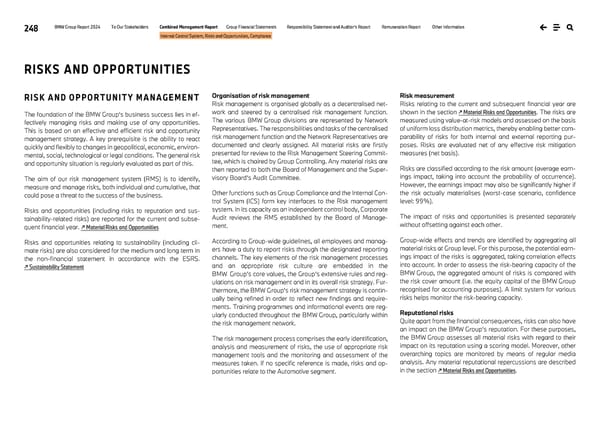248 BMW Group Report 2024 To Our Stakeholders Combined Management Report Group Financial Statements Responsibility Statement and Auditor’s Report Remuneration Report Other Information Internal Control System, Risks and Opportunities, Compliance RISKS AND OPPORTUNITIES RISK AND OPPORTUNITY MANAGEMENT The foundation of the BMW Group’s business success lies in ef- fectively managing risks and making use of any opportunities. This is based on an effective and efficient risk and opportunity management strategy. A key prerequisite is the ability to react quickly and flexibly to changes in geopolitical, economic, environ- mental, social, technological or legal conditions. The general risk and opportunity situation is regularly evaluated as part of this. The aim of our risk management system (RMS) is to identify, measure and manage risks, both individual and cumulative, that could pose a threat to the success of the business. Risks and opportunities (including risks to reputation and sus- tainability-related risks) are reported for the current and subse- quent financial year. ↗ Material Risks and Opportunities Risks and opportunities relating to sustainability (including cli- mate risks) are also considered for the medium and long term in the non-financial statement in accordance with the ESRS. ↗ Sustainability Statement Organisation of risk management Risk management is organised globally as a decentralised net- work and steered by a centralised risk management function. The various BMW Group divisions are represented by Network Representatives. The responsibilities and tasks of the centralised risk management function and the Network Representatives are documented and clearly assigned. All material risks are firstly presented for review to the Risk Management Steering Commit- tee, which is chaired by Group Controlling. Any material risks are then reported to both the Board of Management and the Super- visory Board’s Audit Committee. Other functions such as Group Compliance and the Internal Con- trol System (ICS) form key interfaces to the Risk management system. In its capacity as an independent control body, Corporate Audit reviews the RMS established by the Board of Manage- ment. According to Group-wide guidelines, all employees and manag- ers have a duty to report risks through the designated reporting channels. The key elements of the risk management processes and an appropriate risk culture are embedded in the BMW Group’s core values, the Group’s extensive rules and reg- ulations on risk management and in its overall risk strategy. Fur- thermore, the BMW Group’s risk management strategy is contin- ually being refined in order to reflect new findings and require- ments. Training programmes and informational events are reg- ularly conducted throughout the BMW Group, particularly within the risk management network. The risk management process comprises the early identification, analysis and measurement of risks, the use of appropriate risk management tools and the monitoring and assessment of the measures taken. If no specific reference is made, risks and op- portunities relate to the Automotive segment. Risk measurement Risks relating to the current and subsequent financial year are shown in the section ↗ Material Risks and Opportunities. The risks are measured using value-at-risk models and assessed on the basis of uniform loss distribution metrics, thereby enabling better com- parability of risks for both internal and external reporting pur- poses. Risks are evaluated net of any effective risk mitigation measures (net basis). Risks are classified according to the risk amount (average earn- ings impact, taking into account the probability of occurrence). However, the earnings impact may also be significantly higher if the risk actually materialises (worst-case scenario, confidence level: 99%). The impact of risks and opportunities is presented separately without offsetting against each other. Group-wide effects and trends are identified by aggregating all material risks at Group level. For this purpose, the potential earn- ings impact of the risks is aggregated, taking correlation effects into account. In order to assess the risk-bearing capacity of the BMW Group, the aggregated amount of risks is compared with the risk cover amount (i.e. the equity capital of the BMW Group recognised for accounting purposes). A limit system for various risks helps monitor the risk-bearing capacity. Reputational risks Quite apart from the financial consequences, risks can also have an impact on the BMW Group’s reputation. For these purposes, the BMW Group assesses all material risks with regard to their impact on its reputation using a scoring model. Moreover, other overarching topics are monitored by means of regular media analysis. Any material reputational repercussions are described in the section ↗ Material Risks and Opportunities.
 BMW Group Report 2024 Page 247 Page 249
BMW Group Report 2024 Page 247 Page 249